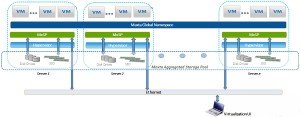This post is also available in: Italian
Reading Time: 4 minutesSome weeks ago I’ve got the opportunity to talk with some people from Maxta Inc. about their storage solutions. Maxta’s mission is to dramatically simplify and streamline IT by thinking outside the storage box. Maxta has redefined enterprise storage, enabling our customers to realize the full potential of the Software-Defined Data Center.
Their idea is simple (and not necessary new): eliminate Storage Arrays and Storage Networking with a completely software based storage solution that provide an hypervisor agnostic, VM-centric Enterprise-class data services for VM agility, continuous availability, data protection, and capacity optimization.
 The architecture of Maxta Storage Platform (MxSP) is almost similar with other common solutions (like for example Nutanix or VMware VSAN): build a scale-out and distributed storage pool by converting local storage in shared storage with all the enterprise functions that are needed.
The architecture of Maxta Storage Platform (MxSP) is almost similar with other common solutions (like for example Nutanix or VMware VSAN): build a scale-out and distributed storage pool by converting local storage in shared storage with all the enterprise functions that are needed.
Like other solutions a virtual appliance (MxSP VA) is deployed on each node, in order to convert local storage in a Maxta Global Namespace, that is basically (on VMware) a NFS datastore. Like other similar solutions it can benefit from a local SSD, that could be used both for a read cache and write back cache, but it’s not mandatory (like for example in VSAN). And some technique for optimize the data on the storage in order to have a sequential destaging, used not only on SSD but also on traditional HDD.
But one really interesting point is that Maxta MxSP supports two kind of server nodes:
- Converged Compute/Storage serve: that include both the compute and the storage part (so with at least one local disk and at least 2 node of this type). Note that local storage could also be without hardware RAID card, because could be provided by software (also on local storage)
- Compute Only server: that could be also a diskless node.
This, combined with the usage of commodity components (including SATA disk and commodity cMLC SSDs), brings more flexibility in design choices and also in scaling.
User cases for this solution could be ROBO (Remote Office, Branch Office), Test and development environments, DR site storage, Virtual Desktop Infrastructure (VDI) and also Mid market and SMB as a primary storage solution for virtual infrastructure.
Is interesting that the initial declared target does not include production environment of big enterprises, but considering that is new product, I agree in a focus on some specific user cases where this kind of solution could bring more benefit (especially in new projects).
Also most of the market strategy is target on VMware customers, but this product is really hypervisor agnostic and could work also on KVM or Microsoft Hyper-V.
Data protection and availability is guaranteed both from a network RAID10 (by default 2 copy in 2 server) but also are used checksums to guarantee data integrity.
Compared to other products with a similar approach, here the main advantages are the hypervisor agnostic, the hardware agnostic (it’s completly software) and flexibility and the VM-centric model (where there is no need to define LUNs, or block level structures). Of course a possible disadvantage from the VM-centric data services approach is that it provide only an NFS storage, not suitable for all cases (and this could be another reason why the big production enterprises are not yet targeted).
For more information see also those blog posts:


